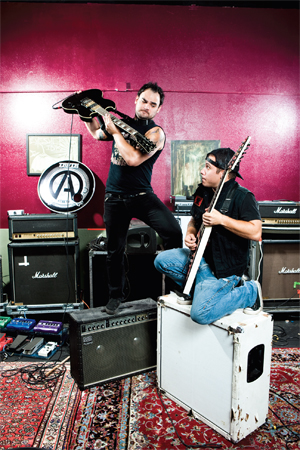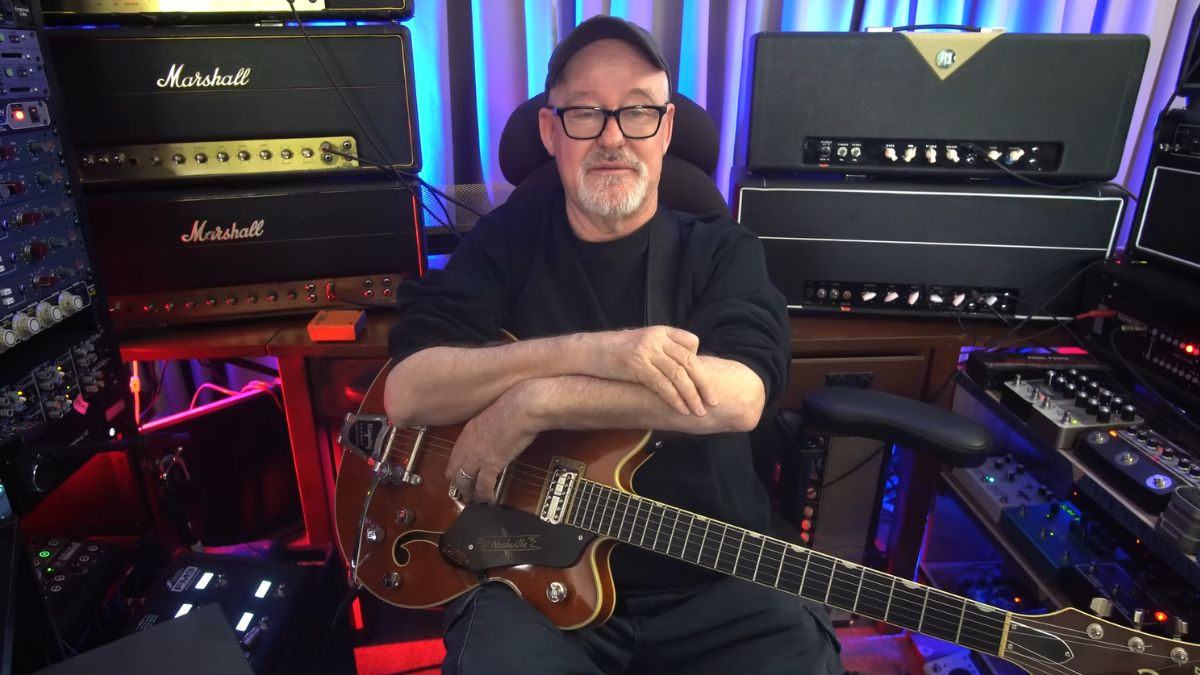Atreyu: Prior Convictions

Originally published in Guitar World, February 2010
Atreyu draw from the most fundamental aspects of their previous records for their latest metalcore masterpiece, Congregation of the Damned.
“We’ve been a band for 10 years now, and this is our fifth full-length album. In a way, this release is really a culmination of all of our records, mixed together.”
Atreyu guitarist Dan Jacobs is discussing Congregation of the Damned, the most recent release from SoCal’s metalcore masters. The band has been busy with press appearances ever since Congregation of the Damned debuted at Number Four on Billboard’s Hard Rock album charts. Fueled by a potent concoction of powerful pop hooks, solid lockstep precision and blazing harmonized solos, Atreyu have followed the success of their last release, Lead Sails Paper Anchor, by raising the bar even higher.
Jacobs continues, “There are elements of Lead Sails on the new record, in terms of the focus on strong vocal melodies, but we also brought in more of the metal attitude that you’ll hear on our previous records, with the throaty vocals and the shreddy dual lead guitar parts.”
Following their recent tour with Hollywood Undead, Escape the Fate and the Sleeping, Jacobs and fellow Atreyu guitarist Travis Miguel dropped in at GW’s headquarters to discuss the making of Congregation of the Damned.
For their latest creation, Atreyu called upon the services of veteran producer Bob Marlette (Ozzy Osbourne, Alice Cooper) and mix engineer Rich Costey (System of a Down, Rage Against the Machine).
All the latest guitar news, interviews, lessons, reviews, deals and more, direct to your inbox!
GUITAR WORLD How did the material come together for the new album?
TRAVIS MIGUEL The writing sessions for the album started in November 2008, and we just hammered out all of the tunes right up to when we started pre-production, which was probably in April 2009. Then we went into the studio, and here we are with a 13-song album. We recorded it in Woodland Hills/Hollywood, in beautiful sunny California.
GW This is the first record with which you worked with producer Bob Marlette. He’s worked with everyone from Alice Cooper to Slayer to Black Sabbath. What did he bring to the table?
DAN JACOBS For just about every record, we’ve worked with a different producer, either because our tastes changed at the time or because we felt that a certain person would be appropriate for that particular project. When we started the new record, we were working with someone else, but it didn’t work out, and suddenly we needed a producer immediately.
A friend of ours was recording and working with Bob at the time, and when we heard the stuff they’d done we thought, Wow, that sounds really good. So we looked into what he’d done, and we saw that he’d just recently finished Lynyrd Skynyrd’s new record, God & Guns.
Bob was great to work with. He wasn’t too pushy, like, “This is the way it’s gotta be.” He was more like, “Okay guys, what do you got?” And he’d say, “This part’s really good, but this part’s not as cool. Try to do something different,” or, “Try to come up with something that has more energy.” And that would inspire us to change things up.
MIGUEL He was definitely not kissing our asses, telling us, “Oh, this record is going to be huge!” He knows that we’re just five douche bags from California.
GW He knew that before he met you?
MIGUEL No, he figured it out as we went along. He was all about doing whatever was best for the song, best for the album and best for the music itself. It was essentially like having a sixth member in the band. And he was there 24/7, whereas some producers will only work with the vocals or the drums, or maybe just the editing process. He was there from day one until the last day, and that was refreshing.
GW Did Bob have any impact on your respective guitar sounds?
JACOBS Definitely. The setup that he has at his studio is pretty awesome. He has a room—I think it used to be his garage, which he rebuilt into his studio—and there’s another house on the side where he keeps all of his amplifiers. I mean, there are probably 10 or 15 different cabinets in there, all sectioned off, miked up and ready to go. And in the actual studio room there’s a big rack of pullout drawers filled with all of these different delay pedals, chorus pedals and so on, everything already patched in. Along with that, there are tons of different heads to choose from, a great variety of Marshalls, Mesas… everything you could possibly think of. So we could come up with all of these different great combinations of sounds very easily. Whatever you’d want, it was right there in front of you. That said, we usually stick with Marshalls for live performance and recording.
GW What Marshalls are you using live?
JACOBS Recently, I’ve been using a JCM900 that I’d bought about 10 years ago. I’d sold it to a buddy and ended up buying it back. It’s the best-sounding head I’ve ever owned.
MIGUEL I’ve been using a Marshall Vintage Modern, which has that old-school hot-rodded JCM800 feel to it. We’ve gone through all of the boutique amps and high-gain amps that are out there, but Marshall is pretty much the industry standard.
On the record, we usually had at least two or three different heads going at once. We brought our live rigs in and combined that sound with Bob’s stuff. There are so many different layers of guitars and overdubs.
GW What is your approach to recording guitar parts?
MIGUEL We work on each section in layers. We literally spend three full days just recording the simple, basic rhythm guitar parts. For some of the songs, I was using a Fender Subsonic Baritone Telecaster, which was a bitch to play, especially after doing 13 tracks. By the end of the day, my fretting hand was completely numb. I had to ice it down every night.
From there, it’s just a building process—coming up with new parts and adding more simplified parts, such as full chords and little riffs. After that come the basic overdubs and the solos.
JACOBS We learned during the making of our last album that it’s great to add a lot of stuff that is very subtle—things that the listener might not be aware of that serve to thicken the sound up. For example, we’d double up guitar parts using different guitars, add high-picking licks and harmonize single-note lines. We might mix those harmony parts very low, but they still make the track sound bigger and more epic.
GW How did the first single, “Storm to Pass,” come about?
JACOBS This song was originally written for our last record, but it didn’t make the cut. During the writing process for this record, we decided to revisit it. We thought the song had a cool feel to it, so we worked on it quite a bit to bring it back to life. It came out so well that it ended up being the first single from this record.
GW You had the chance to go back and hear it with fresh ears.
JACOBS Yes. It was just an acoustic demo, but it sounded like a really good song to bring back.
MIGUEL It was completely different in its original form. That’s one of the most interesting things about making albums: sometimes the finished product ends up being completely different from the original idea. It’s really cool to see the evolution of a song,
JACOBS The chords, most of the riffs and the groove didn’t change much, but we added an extended pre-chorus and changed the bridge, and we added a whole different solo part.
GW You use an alternate tuning for the song, correct?
JACOBS Yes, play in drop C tuning, which is like drop D but with all of the strings down a whole step [low to high: C G C F A D]. Drop C sounds a little more brutal.
GW How would you say that this record is different from what you’ve done before?
JACOBS After every record, you always go back to the ones before and ask yourself, “What was special about this record?” or “What was it about this record that the fans really liked?” We try to take those things into consideration when writing new material. For Congregation, we pulled from everything we’d ever done, and I think this album really shows what we are all about as a band.
